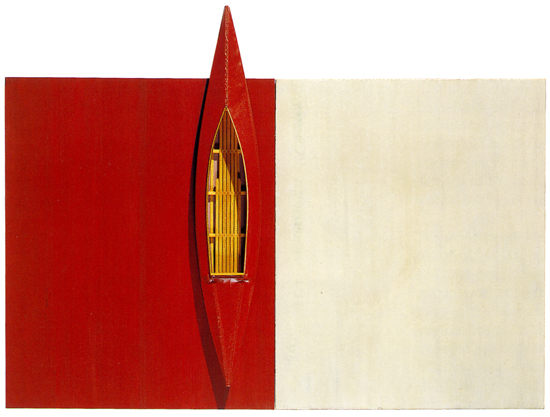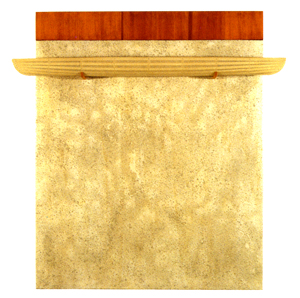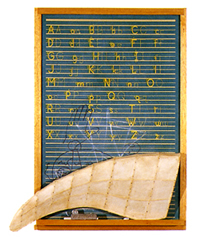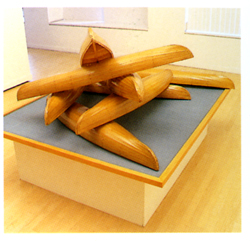| " " |  |
david ruddell essay by Karen Tsujimoto
“… as soon as each hour of one’s life has died, it embodies itself in some material object… and hides there. There it remains captive, captive for ever, unless we should happen on the object, recognise what lies within, call it by name, and so set it free.”
David Ruddell’s quietly elegant constructions are tangible meditations on art and life. The wooden boats, erased backboards, images of birds, and fragments of aged plaster that are variously pieced together in his work appear as embodied reflections on experiences past and journeys yet to be taken. Contemplating these serenely constructed works is like bearing a candle into the dimly lit corners of the unconscious where embedded sensations are, in Marcel Proust’s words, finally set free. The sense of subdued introspection that distinguishes Ruddell’s art has been evident since his early mature work of the 1990’s. But it has subtly evolved over the ensuing years as the artist himself has changed and pondered his life and creative quest. References to childhood memories and experiences that characterize his early pieces, for example, have since given way to altered perceptions that have been distilled and clarified over time. In the early constructions dating from 1990 – 1992, Ruddell carefully mined his past, recasting in his art those essential experiences that have made a difference in his life. From his father, a professor of education, the artist learned to honor the process of teaching and the pleasure of sharing knowledge with others: the give-and-take between teacher and student, father and son, young scout and troop leader. Lessons learned long ago – the satisfaction of accomplishment as when tying a special knot, to have a caring regard for nature, to know and accept the tenuousness of life – have touched the artist in a deep and lasting way and he has respectfully paid homage to them in his art. In Bird/Coiled Rope, 1992 (plate 6), for example, where schoolbook illustrations of a delicate bird hovering near a neatly bound rope appear, Ruddell unequivocally refers to the fragile balance between nature and human invention. The deterioration and timeworn surface against which the images appear only reinforce the unsettling poignancy of the piece. Ruddell has also recalled his love of the materials, textures, and colors associated with his education: the golden glow of varnished wooden desks in faded green classrooms, the gritty feel of blackboards next to the yellowing plastered walls. The numerous references he makes in his work to these early impressions are crucial to the artist’s sense of personal history – a particular color can unlock a flood of latent memories, the feel of a certain texture can evoke an intense emotion. Collectively seen Ruddell’s work of this period evokes the sheltering wrap of childhood experiences and the formative past that is all too soon shed and then abandoned. Through his art, Ruddell explains, he wants to slow down the process of time. Moon Box, 1995 (plate 21), for example, conjures up a myriad of recollections that tap into our collective memory: a classroom lesson in astronomy, a child’s treasure chest of handmade boats, youthful dreams of voyages and escape.
The theme of journeying is, in fact, a major motif that weaves throughout the artist’s work. It has occasionally taken the metaphorical shape of delicately constructed wings in pieces such as Wing IV, 1990 (fig. 2). But most often it appears in the symbolic form of a boat. Exquisitely handcrafted out of various woods, each of Ruddell’s vessels bear witness to love of working with his hands, his respect for fine craftsmanship, and the pleasure he takes in the pure materiality of things. Often his boats appear as pod-like canoes, the wooden skeletons of the vessels sometimes fully covered with a taut, translucent skin of muslin or silk. At other times the boats take the shape of slender kayaks meticulously sanded and shellacked to a burnished hue. Sleek and smooth, the vessels beg to be touched, held, and treasured. Yet despite their finely tuned realism, there is a haunting, evocative quality to these beautifully conceived boats. Frozen in time and space, they appear as perceptible meditations on an inner journey, a voyage into the deep recesses of the mind and heart. The vessels, as the artist acknowledges, are not simply about boats per se, but visual discourses on beauty, spirituality, choices to be made, and journeys to be taken. In White Square/White Boat, 1993 (plate 15), for example, the ragged ethereality of the slender vessel contrasts vividly with the coarse, black-stained plywood against which it is set. Quietly and simply asserting it’s presence, and bolstered by the luminous white square above it, the fragile boat appears
as a poignant metaphor for survival as one sojourns through life. Sometimes, as in 3 Blue Boats II, 1991 (plate 4), several identical boats will appear in a single work, neatly aligned as if moored and awaiting departure. Indistinguishable from one another, the vessels serve as signifiers for the different choices we make in our lives. But as Ruddell observes, the final decisions that are made and the routes that are chosen are often not so different from one another as might be assumed. At other times, as suggested by Pile of Boats, 1997 (fig. 3), ventures will turn awry and plans are literally upturned and abandoned. What also distinguishes Ruddell’s art is his emphasis on the pure physicality of the materials with which he works. This is especially so in the more recent constructions dating from 1996. The sense of subjectivity and emotion that permeated his earlier pieces has gradually given way to more formal concerns in which the nuances of surface handling, contrasts of textures, and relationships between lines, edges, and shapes takes even greater precedence. In White Boat/White Board with Fir, 1997 (fig. 1) and White Boat/Fir Bar/2 Black Strips, 1998 (plate 30), for example, it is the sensual power of color and texture, the tension between edges where blackboard and plaster meet, and the breathing intensity of surfaces that preoccupy the artist. Even the boats seem to have undergone a subtle transformation; there is a cooler, impersonal presence to them as the artist now accentuates their attenuated formal elegance. It is as though in his own personal journey Ruddell has gradually come to a more distilled essence in his art. Seen together, the recent constructions reveal Ruddell’s long-standing interest in the formal clarity and palpable physical reality of his art. As the artist readily acknowledges, he has always been attracted to the natural beauty and tactile character he finds in ordinary materials – the meandering grain of plywood, the silken smoothness of varnished hardwood, the scrabbly look of concrete – and in his recent pieces he communicates this interest with an intensified sense of rigor and focus that marks a turning point in his art. But unlike the minimal artists with whom he shares certain affinities, Ruddell continues to work with materials that are vested with the undeniable subjective significance to him, transmuting them into spare expressions of subtle intensity. Quietly assertive, his works are contemplative explorations into the interface between the past and present, emotion and intellect, the personal and universal. Karen Tsujimoto
|
|||||||||



